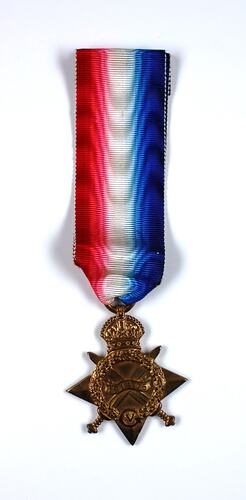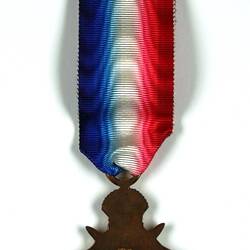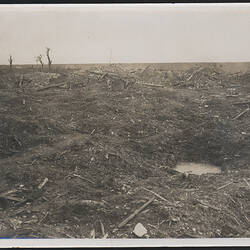Summary
1914-15 Star medal, awarded to Gunner James Clive Talbot. Part of a collection of material associated with Talbot's World War I service.
James Clive Talbot was a 20-year-old grazier and wool classer from 'Yeo Vale', Birregurra, Victoria, when he joined to fight in World War I on 2 April 1915 (service number 1350). As part of the 24th Battalion he served in Gallipoli and on the Western Front. He was killed in action aged 22, on 22 September 1917 in Belgium (during in the Third Battle of Ypres). His father (perhaps both his parents) appears to have taken the unusual step of visiting his grave - out of the reach of many bereaved in Australia. They also placed a blackwood pulpit at the Birregurra Church of England, in memory of their son, who they knew as Clive. It is inscribed '...in loving memory of our beloved son and brother, James Clive Talbot, killed in action September 22nd, 1917, aged 22 years. He has fought a good fight, he has finished his work; he has kept the faith.'
The 1914-15 Star was authorised in 1918 to be awarded to those who saw service between 5 August 1914 and 31 December 1915 (excluding those who were eligible for the 1914 Star) - 2,350,000 were issued.
Physical Description
Bronze four point star medal 'ensigned' by a crown. Ribbon is striped in the three colours of the Empire which are shaded and watered. Single pin on back for fastening (not hinged).
Obverse Description
Four pointed star with the top point replaced by a crown with attached loop and ribbon, crossed swords project between the points of the star and at the centre, within an oak wreath, a scroll crossing the swords reads '1914-15'; at the base of the wreath is a large 'G' which encloses a 'V' (King George V).
Reverse Description
Stamped; 'PTE. J.C. TALBOT. / 24/BN. A.I.F.'.
Significance
The James Talbot mourning collection is of particular significance since it documents a set of personal effects from a son lost at war, including a tiny photograph and engraved medal presented to his bereaved parents, and his colour patch, buttons and badges. Importantly, it also includes a large certificate from Ypres Reservoir British Cemetery, Belgium, including cemetery images and Talbot's details pasted into a box at the centre. (Further research may link this to his father's visit to the cemetery.) It provides an important insight into the ways Australians memorialized the distant graves of their loved ones (discussed by Bart Ziino in A Distant Grief, and others).
More Information
-
Collecting Areas
-
Acquisition Information
Purchase
-
Date Issued
1918 AD
-
Issued By
-
Awarded To
Private James C. Talbot - Australian Imperial Force (AIF), 1918
-
Organisation Symbolised
-
Inscriptions
Obverse; '1914 - 15 / GV' (King George V). Reverse; 'PTE. J.C. TALBOT. / 24/BN. A.I.F.'.
-
Material
Bronze
-
Axis
12
-
Classification
-
Category
-
Discipline
-
Type of item
-
Overall Dimensions
45 (Width), 2 (Depth), 145 (Height)
Height includes ribbon.
-
Box Dimensions
87 mm (Width), 60 mm (Depth), 9 mm (Height)
-
Other Dimensions
45 mm (Width), 2 mm (Depth), 61 mm (Height)
Dimensions of medal
-
Shape
Star with loop and ribbon
-
Keywords
World War I, 1914-1918, Medals, Death & Mourning, Battle of the Somme (Somme Offensive), 1916






